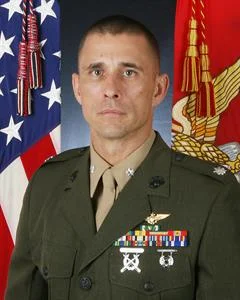My neighbor in South Carolina is Brian W. Foster, a Lieutenant Colonel in the United States Marines, responsible for 720 Marines and oversight of a complex air base. Brian has seen combat duty in Afghanistan and Iraq as well as operated within the hierarchy and bureaucracy of Washington, serving our country with courage, intelligence, loyalty and distinction. Last month, after a 21-year career, he officially relinquished his command.
Brian is a teacher of leadership. As he points out, “The Marines have more experience with leadership training than any other organization on earth.” As Brian and I discussed what he had learned during his years in the Marines, it struck me that many of his insights were germane to today’s school leaders, and, in fact, spoke directly to potential weaknesses in many of our schools. Below are a few of my questions and this Marine leader’s insights:
How did you teach your own staff to be leaders?
Brian noted that there are many technical aspects of leadership—public speaking, clear writing, continuous feedback loops—that can be taught. All emerging leaders should receive training in these areas. However, he also noted, that there was no substitute for practicing and doing. Potential leaders require growing responsibilities, and senior leadership must delegate in order to advance the long-range goals of the organization.
In describing his own leadership style, Brian commented, “Once I learned to do something myself, I made time to teach it to the next-in-command and then made sure I handed over the responsibility to him or her.” Brian viewed this on-going training and delegation as critical both to building capacity on his team and also to providing himself with the time needed to focus on “big-picture” issues and strategic planning.
What else is critical to strategy and leadership?
When I asked about strategic planning, Brian described innumerable hours spent writing strategic action plans, and he underscored again strong writing and verbal communication as a vital leadership skill. He also explained the specific structure of Marine strategic plans. For each military objective, the officer must delineate all actionable goals, each of which must be accompanied by a clear, compelling statement of intent.Equally important, both the goal and the officer’s intent must be communicated effectively all the way down the chain of command to the Marines on the battlefield. In that way, when the unexpected occurs, each Marine understands not just the “what” and “how” of their assignment but also the “why.”
In schools, we often have a clear vision of where we are headed. We may have communicated that objective to our Board and key administrators, but given hectic school schedules and limited meeting time, how often have we clearly and thoroughly communicated it within the entire community? School leaders would do well to consider if their goals and intentions are as well understood by the rank-and-file in their schools as by those Marines in battle.
How are decision-making and leadership practiced in the larger Marine Corps?
While most of us are familiar with Parris Island and Marine boot camp, Brian introduced me for the first time to the OODA LOOP. Developed by USAF Colonel John Boyd, OODA is an acronym for Observe, Orient, Decide and Act, and it drives the decision-making cycle for military strategy. Today all Marines are trained to “observe, orient, decide and act,” and the more experienced the leader, the more quickly he or she can move through the steps required for decisive action. It rewards agility and quickness over power and has been adopted in many business and learning enterprises beyond the military.
What OODA highlights is the critical link between strategy, leadership, and execution. School leaders make decisions every day. It is worth asking, though, if the actual process for making decisions is understood by everyone. Is it based on good data? Does it emphasize action and timely execution? Educators can be notoriously slow decision makers. Perhaps OODA can teach us something about decisive, real-time leadership.
Is there anything intrinsically wired into a great leader that can’t be taught?
Brian thought for a long time. His answer is profoundly applicable to school leadership. To paraphrase Brian’s response: “I work within a group of intelligent and motivated volunteers who have sacrificed to become a Marine, so already I have a self-selected, high-achieving group. As I choose whom to elevate, I look for one critical characteristic that I don’t believe I can teach and that is essential to leadership: the ability, under pressure, to focus on others.”
I asked Brian to elaborate. “Many people display good leadership qualities under normal conditions. However, when the heat gets turned up, when there are deadlines, pressure or stress, many people exhibit or amplify that stress; others draw inward, literally putting their heads down and focusing on what it is they need to get done; and a very few exhibit a wider range of vision and an ability to focus on helping the people around them. That person is a leader because he or she can focus under pressure and lead others to achieve a larger, group goal.”
What does that mean for school leadership? As we seek to identify and elevate the next generation of great school leaders, observe how people perform under pressure and if their focus is on helping others or just on getting their own job done. It’s worth taking a look at our own behavior, too: The next time stress or pressure builds, can we deliberately seek to broaden our own focus and help others meet their goals?
What most distinguishes leadership training in the Marines?
Brian’s response was immediate and unambiguous. “In the Marines, we give intense and continual feedback . . .all the time . . . to everyone! You learn to develop a thick skin and to accept feedback as the best way to learn.” The lesson for us as educators: If we want to learn and get better, we probably need to get tougher, too.
Brian is an exceptional leader, and the Marines are a unique organization with a distinct mission and culture. Powerful schools, however, also have distinct missions and cultures. And this Marine commander’s observations about what he learned over the course of his career made me think deeply about identifying, developing and promoting strong leadership in our schools.

